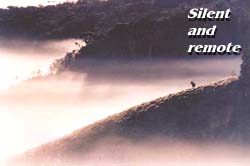 |
 28th June 1998 |
Front Page| |
Silent and remotePart 10 of our series on the environment with Studio Times By Charith PelpolaWild and lonely are the Plains. The elephants are gone, but herds of sambhur roam again with a leopard or two for company. And through an enchanted spring crowds of buttercups and violets, forget-me-not and harebell, dandelion and loose strife “paint the meadows with delight”, while the clear headwaters of the Belihul-Oya run sparkling down to the Galgama Falls - a ten-mile tumble of cascades, pools and shallows, with “here and there a lusty trout....” -Robert Silva, from The Wild, The Free, The Beautiful by Nihal Fernando.
The remote plateau of Horton Plains is perhaps Sri Lanka’s largest, relatively undisturbed montane habitat - home to fauna and flora, found nowhere-else in the world. It stands remote and silent, a windswept saddle of the central mountain massif, beneath the towering ranges of Adams Peak and North Eastern Namunukula. Heavy-coated Sambhur graze cautiously amongst the undergrowth. And the pug-marks of leopard betray the presence of their hunter upon the plains. Horton Plains comprises a vast expanse of uninterrupted grasslands. The tussock grass (chysogon zelanicum), may grow to a height of around 1.5 metres: a protective cover of the thin layer of peat beneath, which in turn, provides the grass with some resistance against the strong winds of the plains. It is this high velocity wind that has shaped the foliage of Hortons. The montane forest holds characteristically stunted trees and plants, that have adapted to these adverse conditions by clinging low to the sheltering ground. A unique species of Rhododendron lends haunting colour to the plains from March to August with deep, blood-red blooms. A stunted species of Clustracene (keena), emblazons its crown with a web of small, reddened, emergent leaves. And Magnolia, that most ancient of flowering plants, grows here, embittered and twisted by the unforgiving elements of time and tempests. Shrouding it all; clinging ghost-like to the branches is the ethereal, epiphytic Old Man’s Beard.
Horton Plains is an ancient and yet entirely vulnerable habitat. Its delicately balanced ecosystem can easily be made unstable. All it takes is the introduction of a foreign species, or vandalism at the hands of men, to destroy this equilibrium. And it is happening. The fires that swept across the plains earlier this year, inflicted immeasurable damage to the area. The hundreds of acres destroyed, will take years to regenerate completely. Some susceptible species may have lost their foothold completely. The introduction of Gorse (Ulex europaeus), has lead to 12 and a 1/2 square miles of the plains being overrun by the exotic weed. It has no predators here, and could well displace the native flora of the park. Consequently, the effect on the lives of animals which depend on specified plants for food and habitation, would be devastating. It may sound alarmist, but these are real possibilities. It is after all, the reason why we are today left with this precious remnant of a montane forest that once encompassed the highland kingdoms. |
||
 |
More Plus * Peopel and Events
Front Page| News/Comment| Editorial/Opinion| Business| Sports | Mirror Magazine |
|
 |
Please send your comments and suggestions on this web site to |
|
 The
wilderness and the Horton Plains Natural Reserve forge a converging plateau,
where two sheer escarpments plummet endlessly from two World’s Ends. The
drifting plains rise from 1,500 to 7,000 feet above sea-level; shrouded
in mist and lingering rain cloud. Four major rivers are born in the heart
of this highland wilderness. The Mahaweli Ganga, the Kelani Ganga, the
Kalu Ganga, and the Walawe Ganga find their sources in the peak wilderness,
before spreading themselves like limpid arteries into the body of the island.
The
wilderness and the Horton Plains Natural Reserve forge a converging plateau,
where two sheer escarpments plummet endlessly from two World’s Ends. The
drifting plains rise from 1,500 to 7,000 feet above sea-level; shrouded
in mist and lingering rain cloud. Four major rivers are born in the heart
of this highland wilderness. The Mahaweli Ganga, the Kelani Ganga, the
Kalu Ganga, and the Walawe Ganga find their sources in the peak wilderness,
before spreading themselves like limpid arteries into the body of the island. The
undergrowth beneath the trees is dominated by the mauve hue of the Nilu
(Strobilanthes). These plants bloom only once in their life span of 7 to
11 years. After they flower, they exhaust their energies and die. In meandering
streams, the only variety of red algae found in Sri Lanka flourished, and
on the banks grow diminutive strands of dwarf bamboo.
The
undergrowth beneath the trees is dominated by the mauve hue of the Nilu
(Strobilanthes). These plants bloom only once in their life span of 7 to
11 years. After they flower, they exhaust their energies and die. In meandering
streams, the only variety of red algae found in Sri Lanka flourished, and
on the banks grow diminutive strands of dwarf bamboo.